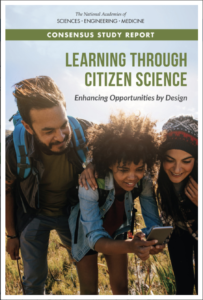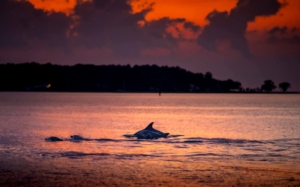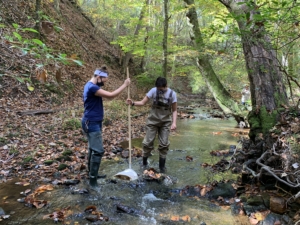Democratizing Science in the Chesapeake Bay
Citizen science creates a participatory pathway for the public to engage in the scientific process and data collection. Through our conversations with the community, we’ve learned that the term “citizen science” can be exclusive and wanted to clarify the use of the term in this article. Citizenship, or the perception that a volunteer may or may not be a citizen, is certainly not a prerequisite for participating in these projects. No matter where a volunteer was born, or how they came to the United States, their contribution is valuable to these science and conservation programs. To the general public, however, the majority of volunteer-based projects are still termed citizen science, so to avoid confusion as we continue to work toward a more inclusive universal term, the projects below are referred to as citizen science projects.
 According to a report by the National Academies of Sciences, Engineering, and Medicine, citizen science can support learning in a number of ways, by offering the opportunity to participate in scientific endeavors in a real-world context, strengthening social interaction that deepens learning, and engaging participants with real data.
According to a report by the National Academies of Sciences, Engineering, and Medicine, citizen science can support learning in a number of ways, by offering the opportunity to participate in scientific endeavors in a real-world context, strengthening social interaction that deepens learning, and engaging participants with real data.
In many cases, the data collected is used by various small, regional groups to monitor the health of their local ecosystems while at the same time providing educational opportunities for their stakeholders. In recent years, there has been increasing awareness among the science and management communities that these observations have real power. That these data are more than just a “warm and fuzzy” effort at stakeholder engagement. On the contrary, citizen science programs are providing scientifically rigorous data at spatial and temporal scales that rival government funded monitoring programs. These data have the potential to influence natural resource management and environmental protection decisions and policies.
Citizen science also includes projects that grow out of a community’s desire to address an inequity or advance a priority. For example, a community group in Oakland, CA, the West-Oakland Indicators Project, self-organizes to collect and analyze air quality data. The group uses that data to address trucking in and around schools to reduce local children’s exposure to air pollution. When communities can work alongside scientists to advance their priorities, enhanced community science literacy is one possible outcome.
Chesapeake Research Consortium (CRC) member institutions participate in various community science projects across the Chesapeake Bay region. These efforts range from water monitoring to dolphin watching, with each of these projects contributing to the growing wealth of knowledge about the watershed. In this edition of Streamline, we’ll explore some examples of these projects and the researchers behind them. Citizen science was also the topic of last week’s CRC Roundtable, a recording of which you can watch here.
Expanding Data Collection
Citizen science can give researchers access to a network of data collectors that greatly expands what is possible with their existing staff . The participation of citizen scientists in a project can increase the number of observations, the speed with which data are collected, increase the geographic range of observations, and/or increase the speed of data processing.

Atacama Desert landscape with a colonized Gypsum rock in the foreground.
Dr. Jocelyne DiRuggiero from Johns Hopkins University researches the stress responses of extreme microbes and the ecology of extreme environments in which they are found, like the Atacama Desert in South America. Conducting fieldwork in these extreme environments can be difficult, especially in the middle of a global pandemic. She started a global citizen science project called Rockiology a few years ago in an effort to expand the collection of samples. The goal of this effort is to try and find people who are interested in rocks and might be willing to send samples from deserts around the world.

Photo courtesy of Chesapeake DolphinWatch user Arden H.
DolphinWatch is a citizen science project based out of the Chesapeake Biological Laboratory, University of Maryland Center for Environmental Science (UMCES). The purpose of this project is to record dolphin sightings in the Chesapeake Bay. Dr. Helen Bailey and her team are working to understand how often dolphins come into the Bay, what areas they use, and why. By using the DolphinWatch app, members of the public can help report dolphin sightings in real time and provide valuable information on dolphin distribution in the Bay. Over the last three years, there have been over 7,000 registered users and over 4,000 reported dolphin sightings, which is more eyes on the Bay than Dr. Bailey’s team could have provided by themselves.

Benthic sampling day with the Izaak Walton League of America and the Alliance for the Chesapeake Bay
Credit: CMC
The Chesapeake Monitoring Cooperative (CMC) formed as a cooperative agreement between the Alliance for the Chesapeake Bay and the Chesapeake Bay Program to integrate volunteer-based monitoring efforts into the Chesapeake Bay Program partnership in order to better understand the health of the Bay and its watershed. The Chesapeake Bay Program has a watershed-wide water quality monitoring network, with stations usually monitored by state and federal agencies. However, a majority of these stations are typically in the larger tributaries and the mainstem Bay. By contrast, the citizen science monitoring efforts typically focus in the headwaters and smaller tributaries. Therefore, by integrating this citizen science monitoring network with the traditional Bay Program monitoring network, data collection is geographically expanded and can be utilized to better assess the health of the Chesapeake Bay.
Data collected by citizen scientists can be a rigorous process of scientific discovery and has made substantive contributions to science and the community. The CMC team has established a tiered framework, monitoring protocols, and quality assurance procedures that enable all data of known quality to be used together across the region, whether it’s collected by volunteers, local governments, or NGOs. These data are publicly available on the Chesapeake Data Explorer, and readily available for use at the state and federal levels. The CMC team continues to work with state agencies across the watershed to integrate data collected through this network into their Integrated Report processes.

Credit: Julie Verdura, Yorktown
Catch the King is a citizen science volunteer program that focuses on tracing the highest astronomical tide of the year. Volunteers use the Sea Level Rise app to drop GPS breadcrumbs along the high-water line during the king tide. The data collected during each event is used to validate the accuracy of an operational forecast model called SCHISM, which is a hydrodynamic model developed by Dr. Joseph Zhang at the Center for Coastal Resources Management at the Virginia Institute of Marine Science (VIMS). SCHISM’s storm tide inundation predictions are then shared through the Tidewatch Map, an online GIS mapping platform that allows users to visualize the model results in their web browser without external software. These data have real-world applications and are used by the city of Norfolk to try and provide automated route guidance updates for emergency vehicles about road flooding. “The efforts of this Catch the King program, along with many others, helped validate our models and add some assurance for individuals that are using those data. Both SCHISM and Tidewatch are products that this particular effort (with data collected by citizen scientists) helps us validate temporally and spatially,” explained Dr. Jon Derek Loftis, the science liaison for the program from VIMS.
Citizen Science in a Pandemic
The current pandemic has brought many aspects of fieldwork to a halt or altered the way that researchers collect data and conduct research. One interesting and unintended consequence of this change to daily life has been an increase in people’s engagement with citizen science. According to National Geographic, citizen science websites in the U.S. have seen both an increase in registered users and data contributions, something that some citizen science projects around the Chesapeake Bay have also experienced.

SERC marine biologist Brianna Tracy holds a plate with marine life pulled from a dock in San Francisco. Credit: Kristen Minogue/SERC
The Smithsonian Environmental Research Center (SERC) pivoted from onsite volunteer projects to entirely online or remote projects. For the Invader ID project at SERC, volunteers look at photographs of settlement tiles that were taken by researchers and help identify marine invertebrates. This project saw almost a 200% increase in the number of volunteers and an increase in the number of identifications. Alison Cawood, the citizen science coordinator at SERC, shared that “this was pretty widespread within the citizen science community, where there were really big upticks, especially in early spring, in remote citizen science projects.”
SERC is also working with local students and schools to engage them from their backyards, including a pilot project looking at otters in the Chesapeake Bay. As part of an otter diet study, students are sent sterilized otter scat and they sort through the scat and look for fish scales, The students then take pictures of the fish scales and submit their pictures to SERC for identification. The project is also asking for volunteers to submit images of otter presence, whether it is scat, tracks, or actual otters to learn more about their behavior.
These independent citizen science projects with online elements are something that SERC plans to continue carrying-out in the future, even when volunteers are able to gather again. “We’re always going to have a core of people coming to serve because we have this great facility and it’s this wonderful chance to actually interact with researchers and things like that that are really special and important and that’s never going to go away. But I do think that it’s really pushed us to think about the kinds of things that people can do otherwise, and I think it will continue to accelerate in the citizen science space and we will probably start having more of these kinds of opportunities,” explained Cawood.
Citizen science contributes daily to environmental and natural resource knowledge, with tens of thousands of volunteers providing high-quality, usable scientific information from their communities. Many large and longstanding projects at CRC member institutions would not be possible without volunteers; they collect data over large geographic areas and produce long-term datasets that benefit the health of the Bay. These partnerships between institutions and the community also provide benefits beyond science, offering the opportunity for an open conversation based on scientific knowledge that more people can access, understand, and trust.
